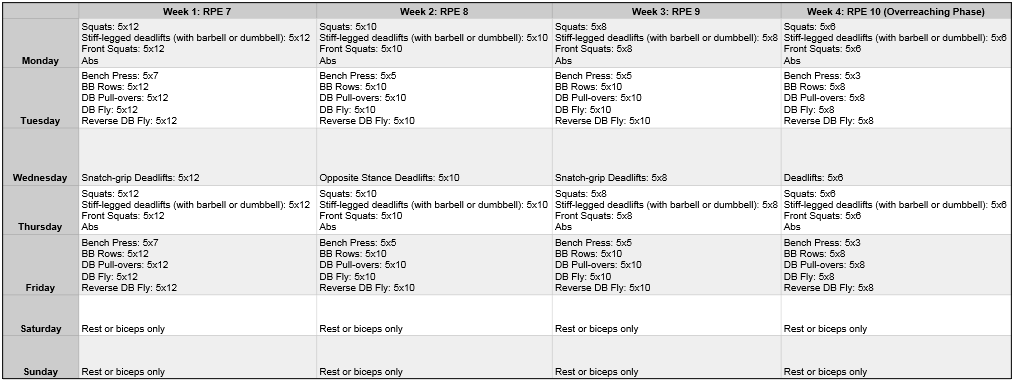
If you’re looking to put on muscle and strength the most efficient way possible using a powerlifting hypertrophy program, you must make sure it includes all three critical mass-building factors.
Get the Physiqz Hypertrophy and Mass Program with included calculators delivered to your email immediately! Note that it is still highly recommended to read this article in full to understand how the program functions and how to properly use it to maximize your progress.
While there are plenty of plans out there, they sure aren’t created equal. And if you pick the wrong one, it can set you back weeks due to slow progress.
More specifically though, almost all powerlifting plans are geared towards building strength—with additional muscle mass thrown in as a mere afterthought.
To avoid that, you have to ensure any mass program you use has three distinct traits:
- Compound movements focused in the lower repetition ranges on bench press, and higher rep ranges on squats and deadlifts
- Large amount of accessory work and volume for maximal hypertrophy
- Solid diet plan to easily put yourself in a caloric surplus each day with high quality foods
With that out of the way, we can dive into the next point.
If you want to get bigger in the gym that means you are going to need to lift heavier weight. Without the proper equipment (especially deadlift shoes), you will put yourself at increased risk for injury. On top of that, the right gear helps to get into a better biomechanical position to improve your leverages and lift more. If you are serious about packing on muscle and expect to keep lifting for many years to come, it is a no-brainer.
Once you have a solid understanding of how to use the gear, you are ready to move into the plan.
To keep things simple and within a 1 month period, the program is four weeks long. With that said, when you finish it is wise to take a deload week to allow your body to fully recover and compensate (make gains) for all of the hard training you’ve done.
The Best Powerlifting Hypertrophy Program Isn’t Your Typical Strength Routine
As stated above, the workouts are all centered around compound lifts: squat, bench press, deadlifts, and overhead press make up the foundation of each session.
But that doesn’t provide enough stimulation to encourage maximal hypertrophy which is absolutely critical for gaining mass.
With that in mind, there are several accessory movements that are much more beneficial to do than others—a bicep curl and a barbell row aren’t even on the same playing field.
When it comes to anything you do, there are diminishing returns. This is especially true when it comes to training because you only have so much “recovery ability,” also known as your maximum recoverable volume.
Because of this, you must pick the best exercises for the job that target multiple muscle groups while still making sure each is sufficiently stimulated for growth.
On top of that, specific movements carry over to the big three much better than others as well. Dumbbell pullovers, for example, have an extremely strong carryover to the deadlift. Lat pull-downs? Much less so.
Because this plan is specifically designed to be used in a bulking phase, there is a large amount of volume with a planned overreaching phase at the end (RPE 10). Why include this?
Studies have shown that just short overreaching phase can make a significant impact on results.
As long as you are sleeping at least 6 hours each night (8 hours is much better), you will have no problem recovering and have nothing to worry about in terms of overtraining.
Lastly, biceps are allowed on both rest days as they recover extremely fast due to their poor biomechanical leverages making it hard to cause unrecoverable damage to the muscle in the course of a 24 hour period.
If you have any questions, be sure to check the FAQ at the end—there’s a good chance yours have been covered.

Week 1: RPE 7
Monday:
- Squats: 5×12
- Stiff-legged deadlifts (with barbell or dumbbell): 5×12
- Front Squats: 5×12
- Abs
Tuesday:
- Bench Press: 5×7
- BB Rows: 5×12
- DB Pull-overs: 5×12
- DB Fly: 5×12
- Reverse DB Fly: 5×12
Wednesday:
- Snatch-grip Deadlifts: 5×12
Thursday:
- Squats: 5×12
- Stiff-legged deadlifts (with barbell or dumbbell): 5×12
- Front Squats: 5×12
- Abs
Friday:
- Bench Press: 5×7
- BB Rows: 5×12
- DB Pull-overs: 5×12
- DB Fly: 5×12
- Reverse DB Fly: 5×12
Saturday and Sunday:
- Rest or biceps only
Week 2: RPE 8
Monday:
- Squats: 5×10
- Stiff-legged deadlifts (with barbell or dumbbell): 5×10
- Front Squats: 5×10
- Abs
Tuesday:
- Bench Press: 5×5
- BB Rows: 5×10
- DB Pull-overs: 5×10
- DB Fly: 5×10
- Reverse DB Fly: 5×10
Wednesday:
- Opposite Stance Deadlifts: 5×10
Thursday:
- Squats: 5×10
- Stiff-legged deadlifts (with barbell or dumbbell): 5×10
- Front Squats: 5×10
- Abs
Friday:
- Bench Press: 5×5
- BB Rows: 5×10
- DB Pull-overs: 5×10
- DB Fly: 5×10
- Reverse DB Fly: 5×10
Saturday and Sunday:
- Rest or biceps only
Week 3: RPE 9
Monday:
- Squats: 5×8
- Stiff-legged deadlifts (with barbell or dumbbell): 5×8
- Front Squats: 5×8
- Abs
Tuesday:
- Bench Press: 5×5
- BB Rows: 5×10
- DB Pull-overs: 5×10
- DB Fly: 5×10
- Reverse DB Fly: 5×10
Wednesday:
- Snatch-grip Deadlifts: 5×8
Thursday:
- Squats: 5×8
- Stiff-legged deadlifts (with barbell or dumbbell): 5×8
- Front Squats: 5×8
- Abs
Friday:
- Bench Press: 5×5
- BB Rows: 5×10
- DB Pull-overs: 5×10
- DB Fly: 5×10
- Reverse DB Fly: 5×10
Saturday and Sunday:
- Rest or biceps only
Week 4: RPE 10 (Functional Overreaching Phase)
Monday:
- Squats: 5×6
- Stiff-legged deadlifts (with barbell or dumbbell): 5×6
- Front Squats: 5×6
- Abs
Tuesday:
- Bench Press: 5×3
- BB Rows: 5×8
- DB Pull-overs: 5×8
- DB Fly: 5×8
- Reverse DB Fly: 5×8
Wednesday:
- Deadlifts: 5×6
Thursday:
- Squats: 5×6
- Stiff-legged deadlifts (with barbell or dumbbell): 5×6
- Front Squats: 5×6
- Abs
Friday:
- Bench Press: 5×3
- BB Rows: 5×8
- DB Pull-overs: 5×8
- DB Fly: 5×8
- Reverse DB Fly: 5×8
Saturday and Sunday:
- Rest or biceps only
Frequently Asked Questions
Q: Why are there no percentages for the sets and repetitions?
A: You should be utilizing an RPE approach. For your last set of each exercise, you should be using the correct weight to hit the correct exertion level. For example, on week four you should be hitting 10 RPE or very close to maximize the overreaching benefits. If you are still confused on RPE, we have covered this in detail here.
Q: Why are there no heavy sets on squat?
A: Lower-body movements respond much better to higher-repetition training, and when included in a training plan that has low repetition on bench, studies have found it’s actually more effective all around at increasing your strength in every lift.
Q: What are opposite stance deadlifts?
A: Choose whatever stance you don’t normally pick—if you normally pull sumo, pull conventional and vice versa
Q: What should you do for abs?
A: Choose exercises that you enjoy and do them—for abs it’s more important to just be consistent, as they are very easy to rationalize skipping after a heavy set of squats and accessory work.
Q: Why does this program not have normal deadlifts until the last week?
A: Deadlift variations carryover extremely well to the deadlift—moreso than variations of any other lift carryover to their respective area. Furthermore, by altering the style of pull (and likely using ones you haven’t before), you can maximize adaptive stress to your muscles by using a unique stimulation each week—more gains.
Powerlifting Routine for Mass: Bulking Diet Made Easy
Note: if you haven’t yet, after reading the tips below check out the huge powerlifter nutrition guide that breaks down everything about food and how to best utilize it to build strength and muscle.
If you search for bulking diets you are sure to find plenty of bland advice on “just eating more” and add more to your plate at each meal.
While the reasoning is sound that you need to be in a caloric surplus, it doesn’t provide much more than that—which we already know. You have to eat more than you burn to get bigger.
With that said, here are some incredibly easy ways to add on weight during your training.
- Wake up in the middle of the night or simply make a trip to the kitchen when you wake in the middle of the night to use the restroom; drink a shake with casein protein and go back to bed. That’s an easy 400-500 calories if you use whole milk.
- Get a bottle of raw and unfiltered honey and take it with you—pouring some into your mouth is a tasty treat and provides an insane amount of calories. To make better use of the carbohydrates and enhance your training sessions, however, you should aim to drink it just before, during, and after you lift.
- Liquid calories will always be easier to get down in large quantities—if you can blend it, do it. Chocolate milk is another easy win.
Now we’re to the point where we need to talk about numbers.
To gain one pound you need to eat roughly 3,500 calories more than your maintenance level. In general, when gaining weight the number to shoot for is 1-2 pounds per week to ensure you are gaining as little fat as possible.
With that said, in the case of strength athletes being lean isn’t the number-one concern and gaining 3-5 pounds per week is common in an off-season or powerbuilding phase.
To put this in perspective, say you wanted to gain 20 pounds in one month.
This means over the course of the month, you need to consume a total of 70,000 calories above your maintenance to gain 20 pounds. This might sound insane but when you break it down, it becomes much more manageable.
On a much more granular level, you need to eat an extra 2,330 calories each day. With the 3 methods above (especially the honey tip) this becomes an easy task.
To calculate your maintenance level of calories (how much you need to eat to simply maintain your bodyweight), you can use a very nifty equation to find the estimated range:
Bodyweight (lbs) * 14 – Bodyweight * 17 = calories needed to maintain
For example, if you weigh 200 pounds, you need to eat somewhere between 2,800-3,400 calories each day. To gain 20 pounds in 1 month then, you would need to eat 5,130-5,730 calories each day if you weigh 200 pounds.
But maybe you don’t need to gain that much that quickly. Simply adjust your calories based on that and follow the same plan above.
